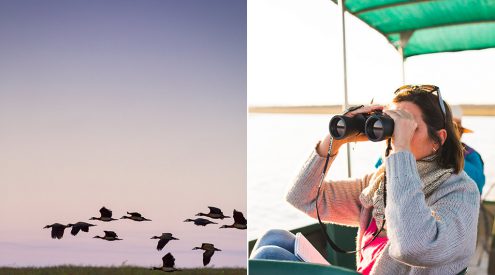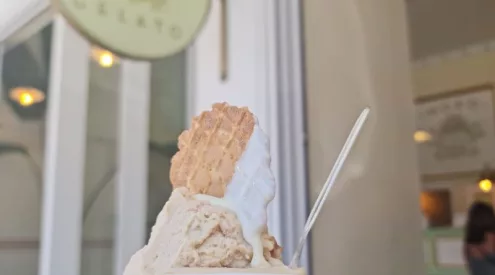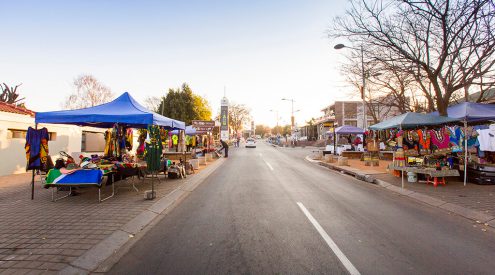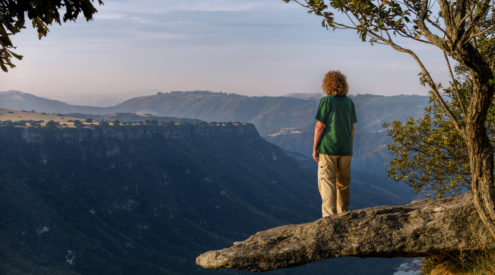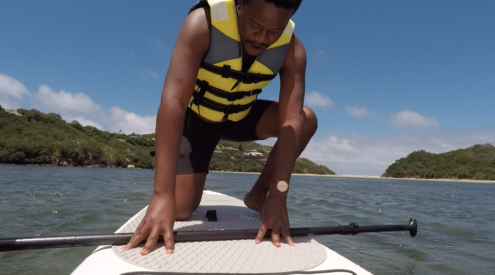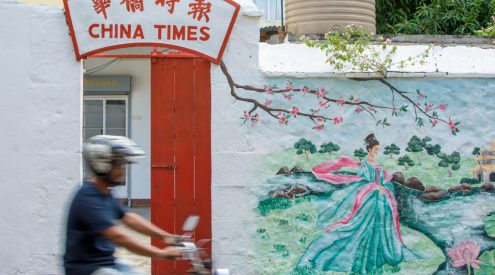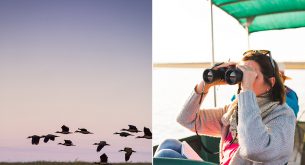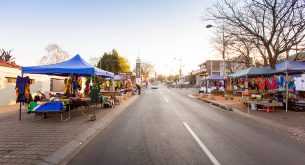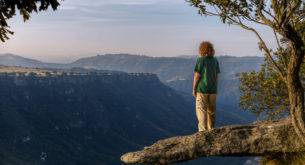4000 kms, no radio, 10 days. That’s what I call an epic road trip.
I went on assignment to Namibia in August to research three stories for the magazine: Luderitz, the NamibRand Private Nature Reserve and a budget road trip around Southern Namibia. So, with three stories to cover in 10 days, there was a lot of ground to cover and a lot to do. My boyfriend, Joe, joined me on the trip (driving 4000 kms by yourself is not
ideal) and he only had to take four days of leave – there was a public holiday that week.
What I set out to do was show people that it’s possible to take only four days of leave and do a pretty awesome overland African road trip. Apart from petrol (our Merc G3100 chowed diesel) the trip was pretty cheap (barring a night of luxury at Wolwedans in the NamibRand). Campsites in Namibia are generally great. Food is more expensive in Namibia than in South Africa, as almost everything apart from meat is trucked up, so take as much of your own from home as you can fit in your car.
Basically, there’s no excuse not to hand in your leave form, pack the padkos and passport and hit the road!
Here’s how we did the trip:
Day one
I pick up Joe from his office at 15.30 on a Friday afternoon, with that excited just-about-to-go-on-a-long-road-trip feeling. Our Merc 4×4 is so big I’ve just thrown in all our stuff in the boot but I have carefully planned out our padkos (essential for any road trip, and particularly Namibia where there aren’t a lot of roadside stops). We ignore our GPS and mistakenly take the N1 to Bellville, before realising we were suppose to have turned off miles back. It’s always good to start a long trip with taking the wrong road.
We drive through the beautiful Cederberg at dusk and revel in being on the open road. We munch on the avo, hummus and veggie sausage wraps I made and hit the northern Cape, with its fantastically named towns (Pofadder, Nababeep, Okiep). It’s so dark outside that it’s like being in a cupboard. Eventually we make it to Kamieskroon at 21.30 and check into the delightfully quaint Kamieskroon Hotel, which smells like my grandmother’s rouge.
Day two
Early wake up in Kamieskroon. Our alarm goes off and we can’t move. I’m sleeping in a beanie and hiking socks and I don’t want to get out of bed. We manage to bundle ourselves together and leave the hotel before anyone else is up. Dawn breaks and we finally can see the vast Northern Cape landscape, with touches of spring flowers. The border crossing is uneventful and quick – we’re in and out in under an hour. After a debate on whether to take the dirt road to Aus or the tarred highway, we decide that the trip is about going off the beaten track and we opt for dirt. This ends up being the greatest decision of the trip – we hardly see tar again until the last day. We drive through the other-worldly Richtersveld/Ai-Ais Transfrontier Park, passing no other cars and feeling like we almost have the place to ourselves.
The one-hour time difference in Namibia confuses us as the GPS suddenly announces we’re arriving in Aus an hour earlier. We arrive at our campsite at Klein Aus Vista at lunchtime. Joe sets up camp under a massive sociable weaver’s nest while I make avo and boiled egg sarmies, which the birds practically try and eat out of our hands. The campsite is fantastically quiet and lovely – the perfect place to chill after a long drive.
We go for a long walk in the hills above camp before driving out towards Luderitz to spot the wild horses of Garub, which is what people come here to see. We find them congregated around a waterhole on the side of the road and can’t stop taking photos: they’re healthy, and beautiful and we’ve never seen wild horses before.
We drive back to camp in the golden dusk and get started on the fire, cracking open our first Windhoeks of the trip as the sun sets. This is what camping in Namibia is all about. The night is freezing and the wind blows all night, threatening to take our tent down, so it’s a restless sleep for both of us.
Day three
As the wind dies down, the social weavers start tweeting. We wake up to a beautifully still day and a campsite littered with the remains of our pasta dinner. The birds must have gotten hungry in the night. Joe packs up the campsite while I make a breakfast of peanut butter and banana sandwiches. Washing up dishes in the ablution block makes my fingertips freeze but the lovely hot shower makes up for it.
Before the sun gets glary we hit the road to Luderitz, getting excited when we drive past our first sand dunes of the trip. Luderitz is a strange little town on the coast, surrounded by diamond mines and the ghost town of Kolmanskop, which is our first stop. We take a tour of the town, learning about how it was established following the discovery of diamonds, and was abandoned 50 years ago when bigger diamonds were found at Oranjemund. Kolmanskop must be one of the most photogenic places in Namibia and we spend an hour walking around on our own, exploring the broken down houses being taken over by the desert.
Sunday is a bad day to be in Luderitz – the town is just about as deserted as Kolmanskop. Nothing is open, apart from Goerke House, a historical house with a great view of the town. With nothing else to do, we wander around the eerily quiet streets of Luderitz before heading back to our home for the night: the lighthouse on Shark Island.
Day four
Another early morning pack up – we want to be on the scenic roads to the NamibRand Private Nature Reserve as soon as possible, so we have time to stop for photo ops.
We go off the main road onto the C27 and D826. These are supposed to be the most scenic roads in the whole country. Think long, straight, red, dusty roads surrounded by mountains, silvery swathes of grassy plains punctuated with terracotta dunes. And silence. We only pass a couple of cars on the entire three-hour drive. We often stop the car to take photos of the scenery and can’t stop marvelling at the glorious, wonderful silence.
We arrive at Wolwedans, one of Namibia’s top lodges, and are blown away. Wolwedans has a few camps on their land in the NamibRand, and we’re staying at the Dunes Lodge, which blends into its environment: terracotta and ochre buildings open out onto the plains and dunes of the desert. We spend the afternoon walking around the camp, taking photos and going on a game drive, and end off the day with sundowners on top of a dune surrounded by vast silence. After a delicious three-course dinner, we fall asleep to the sound of nothing and the city seems like a place we’d never want to return to.
Day five
We wake up when a tray of tea, coffee and biscuits is placed at our front door just before the sky begins to lighten. We sit in bed, warmed by freshly plunged coffee, watching dawn break over the desert landscape. After breakfast and a game drive we (sadly) leave Wolwedans and drive through the NamibRand to the office of Tok Tokkie Trails.
Tok Tokkie Trails offers two-night, three-day trails in the reserve but unfortunately we can only do one night. We set off in the afternoon with our guide, Mike, and a French couple. Mike leads us through the reserve, talking about the desert and its creatures as we go. In the late afternoon we reach “˜camp’ – a semi-permanent kitchen set up on a hill with “˜bedrooms’ spread out from it. Our “˜bedroom’ consisted of two stretchers with bed rolls and a paraffin lamp. After drinks and snacks, we sit down to a three-course meal prepared by the chef and then tuck ourselves (bellies full of food and wine) into our bed rolls, which are warmed with hot water bottles. I fall asleep staring at the milky way and wake up just before dawn to watch the sky lighten slowly from inside my warm and comfy bed roll in the middle of the oldest desert in the world. I’ll go back to Namibia just to do that again.
Day six
We could have stayed on the walking trail for a week but time is short and we’ve got half of Namibia to cover. We hit the (gravel) road to Sossusvlei and after a quick toasted sarmie at the NWR restaurant we head out to Sesriem Canyon. It’s 35 degrees but refreshingly cool in the canyon, which is filled (bizarrely) with American Girl Guides.
Our real mission Sossusvlei at sunset though, so after a couple of quick photos we drive the 60kms out to the dunes. Our plan is to shoot a cover photo for the magazine, which is not that easy in the glare of the afternoon. We assume that everyone comes out to Sossusvlei in the morning for sunrise, as we practically have the place to ourselves. We shoot multiple GBs of photos, hardly talking to each other, awed by the epic landscape of undulating apricot dunes, stretching to infinity. Deadvlei, with its cracked mud puzzle pieces and eerie dead trees, was my favourite spot, especially for photos, but we have to rush out to get to the gate of the park on time, before it closes at sunset.
Camp that night was Sossus Oasis – a seriously jacked up campsite. Each site has its own block with a sink, toilet and hot water shower. We stock up on food at the campsite shop – feta, avo, beer and apple strudel and make pasta, washing it down with thirst-quenching Windhoek.
Day seven
We wake before dawn and are picked up to go for a hot air balloon ride over the Namib. I’m so excited I can hardly talk – I think this is the first thing I’ve ever done that’s on my travel bucket list (it’s a long list). Taking off at dawn, we watch the sun rise over the Namib-Naukluft National Park, fly over dunes that look like play-dough and startle ant-like gemsbok. We have an exciting “˜sports landing’ (we have to hold on to the basket as we tip over on impact) and then a lavish champagne breakfast is laid out for us at the foot of some dunes. We sip bubbly and munch on zebra salami, smoked salmon and croissants in the middle of the desert. It’s pretty special.
We get back to camp and pack up our tent, only to find the birds have eaten the apple strudels we bought for padkos. I’ve heard a lot of good things about baker Moose’s apple pies in Solitaire, so we make a plan to stop there on our way to Swakopmund. We meet Moose and buy his apple pie (which is indeed delicious, and very filling) and find it hard to drag ourselves away from the lovely Solitaire oasis.
We left Sossusvlei when it was pushing 30 degrees and when we drive into Walvis Bay the temperature drops around 20 degrees. We get out the car in shorts and t shirts and get funny looks from people bundled up in coats and scarves. It sort of feels like arriving in Germany.
We wander around the cold streets but we feel strange to be in a town after being surrounded by desert for the last few days, and feel even stranger when we go out to quite a posh restaurant, Jetty 1905, for delicious tapas and wine (we needed a break from Windhoek).
Home that night was at the Dunedin Star Guesthouse (pronounced dun-eeden, but I keep called it dooned-in, for some reason): simple, cheap and clean. All we need, really.
Day eight
You can’t come to Swakop without doing one of the adventure activities on offer. We choose sandboarding over skydiving (we’re sissies, I know) and are driven out to a sea of dunes with a big group of chatty overlanders. Sandboarding is harder than I thought it would be and I turn out to be pretty useless, practically gripping onto the dune all the way down. To be fair, it was quite steep. We all celebrate not breaking a leg afterwards with beer and sandwiches, which go down particularly well with the overlanders.
It’s a miserable afternoon in Swakopmund, which we spend in a coffee shop eating big hunks of carrot cake. Then the sun comes out for a brief moment and we frantically run around town taking photos of the strangely out-of-place German buildings.
Before dinner we pop into the Swakopmund Brauhaus for a couple of pints of Camelthorn Weissenbock micro-brewery beer – highly recommended. The brauhaus is so German (food, drink, people, architecture) that we have to keep reminding ourselves of being in Africa. Everyone had recommended the Tug, a popular seafront restaurant, so we head there for a huge seafood dinner.
Day nine
Wow, Swakopmund is foggy at 5 am. We drive through pea-soup fog for miles along the gravel road towards Windhoek, without even being able to see a metre in front of us. Suddenly it lifts and the sun rises and we’re on a beautiful stretch of road through undulating hills. We don’t see another car for a couple of hours and the scenery is fantastic. We spot kudu and baboon and desolate farms in the middle of nowhere. Then we hit tar at Rehoboth and it’s the long, straight B1 all the way down to Keetmanshoop. It’s a hellishly boring drive that completely tires us out – the glare of the sun, the long straight road, no radio.
Eventually we turn off onto a gravel road to the Fish River Canyon. We timed it just right because we arrive at the canyon viewpoint just before sunset and get some awesome pics of the magnificent canyon. As dusk falls, we make it to NWR’s Ai-Ais camp. A soak in the hot springs and heated pool (which are empty, as there’s a rugby game on and everyone’s watching on a small tv on the veranda) followed by a couple of Windhoeks are just what we need after a long day.
Day ten
I wish we’d had longer at Ai-Ais but we’re up at 5 am again and on the road to the border. Confusingly, our GPS and map differ in opinion about the route we decide to take, which is always a little disconcerting. However, we arrive at the border having shaved off some time with our sneaky short cut. The Namibian Defence Force is there in their colour-coordinated tracksuits, crossing over the border. The whole crossing takes about 10 minutes and as we’re about to drive back into the Northern Cape, the border policeman asks to check our bags. We comply, and he responds ‘No it’s fine – if you had something illegal you wouldn’t have said I could check my bags. I trust you – you look like trustworthy people. Now don’t let me down.’ Erm…. ok.
The Northern Cape is unbelievably green and dotted with spring flowers. In fact, there are blooms alongside the road for pretty much the whole drive down to Cape Town. As we drive through the Cederberg I start planning my next camping weekend there. We stop for a coffee break at De Tol farm stall on the top of Pieknienikers Pass…. and then it’s the last push to Cape Town, which looks sparklingly green after our days of unending brown in Namibia. I have a sense of strange unsettledness as we drive into town – that feeling that is at once familiar and distant that you get when you’ve been away for awhile. It’s a little overwhelming coming back to such a big city – sometimes you feel as if there are only about 10 people in the whole of Namibia.
Weeks later, I’m still finding grains of red Namib sand in my clothes and shoes – a welcome reminder that the vast landscapes of the Namibian desert are still there and that I need to go back… soon.
Contacts and prices
Kamieskroon Hotel
Contact: [email protected],
027-672-1614, www.kamieskroonhotel.com
Cost: R600 a double room, R80 a person for camping.
Info: Kamieskroon Hotel has simple, basic rooms with ensuite bathrooms, and a restaurant.
Klein-Aus Vista campsite
The campsite at Klein-Aus Vista was one of our favourite places to stay on the trip. Our site was at the back of camp, so we had a little exclusive spot all to ourselves under a camelthorn tree, surrounded by the mountains of the private reserve.
Contact: Desert Horse Campsite at Klein-Aus Vista
Cost: R80 a person.
Info: Each site has a tap and braai. The ablution blocks are super clean and have hot water.
Luderitz Lighthouse
Contact: Namibia Wildlife Resorts, [email protected], +27 21 4223761, www.nwr.com.na
Cost: R220 a person.
Info: The lighthouse sleeps four people and has two bathrooms. There’s a kitchen with a stove and microwave (the oven doesn’t work though). There’s also DStv. The lighthouse definitely has the best views in town.
Kolmanskop
Contact: Ghost Town Tours, [email protected], +264-63-204-031
Cost: It costs R55 a person for a permit to visit Kolmanskop, which includes a tour with Ghost Town Tours. You need to buy your permit before you get to Kolmanskop from Ghost Town Tours, located in Luderitz.
Info: You can also get a photographer’s permit, which allows you to visit Kolmanskop at sunrise and sunset.Wolwedans
Wolwedans Dunes Lodge
Contact: [email protected], tel + 264-61-230-616, www.wolwedans-namibia.com
Cost: R3900 a person, including food, drinks (apart from imported spirits and some wines) and activities.
Info: The Dunes Lodge has nine ensuite rooms with verandas. The lodge has a lounge area, pool, dining room and outside deck. It is expensive, but it’s worth splashing out on if your budget will allow it. Waking up in the morning to the vast expanse of the Namib desert is spectacular.
Walking trail in the NamibRand Private Nature Reserve with Tok Tokkie
Contact:Tok Tokkie, tel +264-61-264-521
Cost: For SADC residents it costs R1452 a person a night in the high season, which is July, August and September (the walking trail is two nights and three days). Low season rates (all months except July, August and September) start at R1386 a person a night. The rates include a guide, meals, drinks and equipment.
Info: You don’t need to take anything with you other than your bag (which is transported for you) and your camera. All the sleeping equipment, linen and towels are provided.
Sossusvlei
Contact: You need to get a permit to enter the park from the NWR office, before the gates to the park.
Cost: The permit costs R60 a person (for SADC residents) and R10 a car.
Info: The park opens at sunrise and closes at sunset so you have to time your trip well – it takes an hour to get from Sossusvlei to the park gates.
Sossus Oasis Campsite
Contact: [email protected], tel 021-930-4564, www.sossus-oasis.com/camp
Cost: R150 a person a night, and R115 a campsite
Info: Each campsite has its own stand with hot water shower, light, electricity point, toilet, sink and braai area. The well-stocked petrol station shop a few metres away has all the supplies you’ll need for camping.
Hot air ballooning in the Namib
Contact: Namib Sky Balloon Safaris, tel +264-63-683-188
Cost: R3950 a person
Info: The cost includes pick up and drop off from several hotels near Sossusvlei, as well as breakfast.
Jetty 1905
Contact: +264-64-405-664
Info: The restaurant at the end of the pier. Book ahead. It serves tapas, sushi and great seafood. There’s a nice selection of wine. Go in the late afternoon to catch a fantastic sunset.
Dunedin Star Guesthouse
Contact:[email protected], tel +264-64-407-105, www.dunedinstar.com
Cost: R470 for a double room
Info: Rooms are small and basic, but clean and comfortable. There’s a restaurant. The guesthouse is close to the centre of town.
Sandboarding in Swakopmund
Contact: Alter-Action, tel +26464402737
Cost: R385 for stand-up boarding and R280 for lie-down boarding
Info: The cost includes pick up from and drop off at your hotel/backpackers, several hours of boarding, lunch and beer – it’s a great deal.
Contact: tel +264-64-402-214
Info: Book ahead for dinner (think hearty German favourites, such as eisbein) or enjoy Camelthorn and German beers at the bar.
Contact: tel +264-64-402-356
Info: Book at least a week in advance for dinner at the Tug in peak tourist season (July and August and South African/Namibian school holidays).
Ai-Ais Restcamp
Contact: Namibia Wildlife Resorts, [email protected], +27 21 4223761, www.nwr.com.na
Cost: It costs R125 to camp at Ai-Ais.
Info: Ai-Ais Restcamp is a great place to spend a night or a few days before driving back to South Africa – it’s only a couple of hours from the border.

